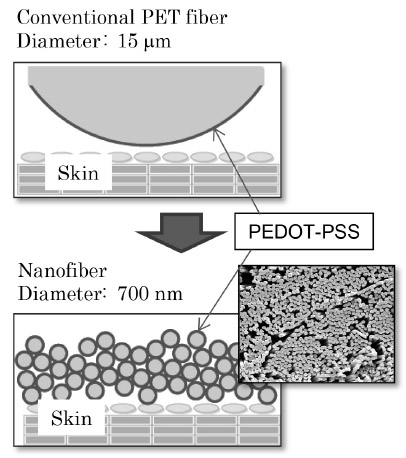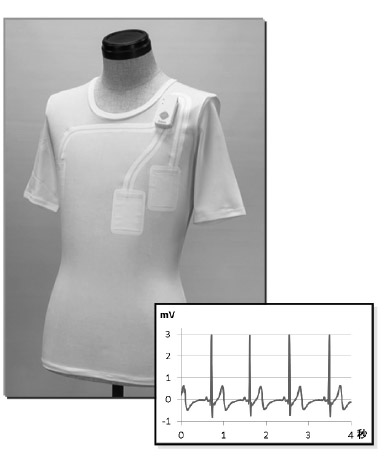Sensing Fabric "hitoe" to Continuously Monitor Bioelectrical Signals
We fabricated flexible and highly biocompatible electrodes consisting of a conductive polymer PEDOT-PSS combined with textiles or threads in order to detect biomedical signals [1]. In this paper, we describe the new sensing fabric "hitoe", which has been developed jointly by Toray Industries, Inc. and NTT.
By coating PEDOT-PSS on an advanced nanofiber textile (diameter 700 nm), we have successfully fabricated "hitoe", which is an extremely durable sensing fabric that is sensitive enough to detect weak bioelectrical signals. Figure 1 shows the difference between this and the previous technique. A thin layer of PEDOT-PSS coated on the textile provides electrical conductivity while retaining the characteristics of the fiber itself, namely air permeability, flexibility, and a feeling of softness. The nanofiber textile, whose diameter is more than 20 times less than conventional PET fibers, provides better electrical conductivity and greater durability against washing, because the surface area for coating is increased. Furthermore, since the points of contact with the skin are also increased, which allows the material to fit the body more closely, contact resistance between the skin and the electrodes is reduced. The bioelectrical signals can be monitored without using any electrolyte paste, which is indispensable with conventional medical electrodes. When "hitoe" is mounted on a shirt, the heart rate and electrocardiograms can be recorded simply by wearing it (Fig. 2).
Using our sensing fabric "hitoe", we will attempt to commercialize a clothing-type bioelectrical sensor and introduce new services that utilize "hitoe" incorporated in a clothing-type bioelectrical sensor and a smartphone.
- [1]
- S. Tsukada, H. Nakashima, and K. Torimitsu, PLoS ONE 7 (4) (2012) e33689.
 |
 |
|
|